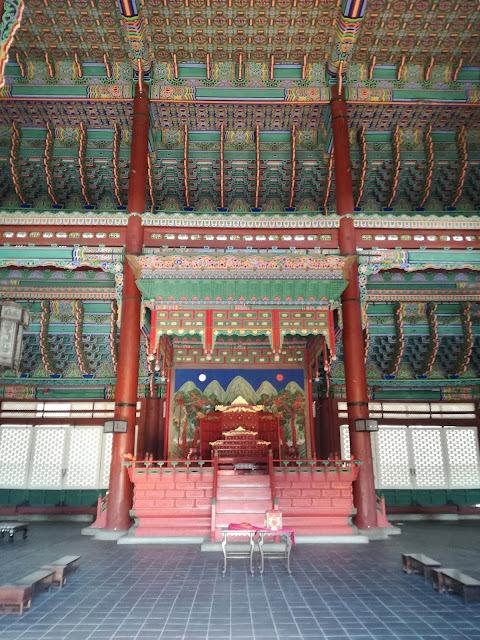From Hoegi, we stopped at Jongno sam-ga and transferred to Line 3. The second stop is Gyeongbokgung station.
 |
| The train station is rich in history and culture in itself. |
From Exit 5, you will see the National Palace Museum of Korea first.
And then the magnificent Gyeongbokgung palace.
Gyeongbokgung was built in 1395 and is largest among the Five Grand Palaces built by the Joseon dynasty. Gyeongbokgung, which means “palace greatly blessed by Heaven”. It has been the center of Korea for so many decades.
And it’s really astounding seeing how the palace’s beauty was preserved and still standing firmly, serving as an iconic sight of Korea.
 |
| Entrance coming from the National Palace Museum of Korea |
 |
| Ticket booths |
 |
| Our ticket |
 |
| Ancient drum located near the ticket booths |
 |
| Guards' boots |
 |
| The famous Gwanghwamun gate. It is the main and south gate of the palace. |
Following the large courtyard upon passing through Gwanghwamun gate is Heungnyemun Gate.
 |
| Heungnyemun Gate (Second Inner Gate) |
Then, you will pass through the third gate, Geunjeongmun, in order to get to the throne hall. This gate was used for small audiences between the king and his civil and military officials. Coronations were held here before.
 |
| Geunjeongmun Gate (Third Inner Gate) and Yeongjegyo Bridge |
In between the second and third inner gates is the Yeongkegyo Bridge and the stream.
 |
| Women in hanbok playing at the courtyard |
 |
| Geumcheon or Forbidden Stream |
On top of the bridge's posts, you will see the mythical creatures known as Seosu.
Stepping on the courtyard and walking on the path towards the throne hall suddenly made us remember how many people shed their blood here in order to protect the country.
Anyway, we are now on Geunjeongjeon Hall (which means "all affairs will be properly managed if Your Majesty demonstrate diligence"), the main throne hall of Gyeongbokgung. It was built in 1395 and is the largest and most formal hall at the palace.
We used to watch this in historical K-dramas only and now we are able to see it "live".
 |
| Tourists can view the throne hall from here. It is hard to take a shot since there are lots of tourists. This is actually on the right side of the hall |
Behind the throne is the "Irworobongdo", a Korean folding screen showing the painting of a red sun and a white moon above five peak mountains. The sun and moon symbolize the king and queen while the five peaks denotes a mythical place.
On the ceiling are two gold dragons circling around the moon. This symbolizes the king and its success.
At the sides of the hall, you will see various cast-iron containers (드므) holding water to ward off evil fire-causing spirits.
 |
| At the back of the throne hall |
 |
| The pavilion is surrounded by the lotus pond. |
 |
| My sister trying to spy on the princes meeting up and having fun in the pavilion (Moon Lovers: Scarlet Heart Ryo). |
Our next stop is Gangnyeongjeon Hall. It was named after the virtue of health and served as the living quarters and resting area for the king.
Just behind it is Gyotaejeon Hall, the main living quarters and resting area for the queen.
After the sleeping quarters, let's now go to the formal halls.
Sajeongjeon Hall is a building used as the main executive office by the king during the Joseon Dynasty.
 |
| King's throne inside Sajeongjeon Hall. |
Beside it are two separate buildings, Cheonchujeon and Manchunjeon.
 |
| Manchunjeon Hall |
 |
| The vent (square hole at the base of the building) is for the 'ondol', the under-floor heating system. |
Some other notable details inside the palace are:
While sitting at the floor of Manchunjeon, we discovered these figures on top of the roofs. And according to what I've read, these are other mythical creatures that guard the the palace.
You will also notice these various
patterns and colors painted on palaces.
This is called ‘dancheong’, which literally means ‘red and blue-green’ in Korean. It doesn't only adds decor to the palace, but it also protects the wood from fungal decay and attack by termites.
In two hours, we are able to see 17 out of 29 places here in Gyeongbokgung. Below is the map and list of places to visit in Gyeongbok.
 |
| Source: http://www.art-and-archaeology.com/korea/seoul/gyeongbokgungmap.jpg |
Next time, we will explore it and the rest of the palaces in Hanbok ^_^. We wanted to do it in Spring so it's not too cold.






















No comments:
Post a Comment